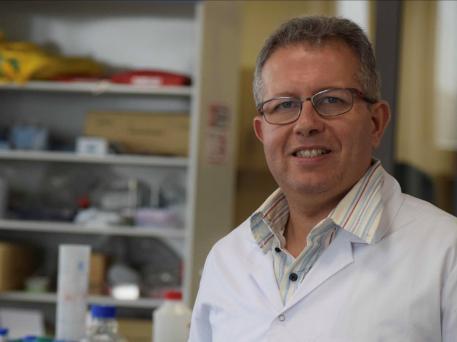News and events from the Institute of Cancer Therapeutics
You can find notable news articles relating to the Institute of Cancer Therapeutics below.
November 2024
Donors help fund cutting-edge ‘radiation source’ to help develop cancer cures

Donors shared their pride in supporting the initiative. In Sue’s Name, a charity established to honor Sue Blasotta, who succumbed to a brain tumor, sees this equipment as pivotal in advancing glioblastoma research. Lorraine Lucas, another donor, commended the dedication of ICT’s staff after visiting the facility, describing it as inspiring and impactful.
ICT’s history of innovative cancer research includes the Crocus Smart-Bomb, a treatment targeting solid tumors with minimal harm to healthy tissues, currently awaiting clinical trials. The institute is also exploring DNA metabolism as a therapeutic target for conditions like cancer and dementia. With the CellRad+ system, ICT strengthens its commitment to delivering better, faster, and more personalized treatments. This milestone not only benefits local patients but also positions the university as a global leader in cancer research, promising transformative impacts on healthcare worldwide.
Read more here
Engineering PSMA-targeted nanoparticles co-encapsulating mitoxantrone and indocyanine green for precise combinatory therapy in prostate cancer
Prostate cancer is the 2nd most common cancer in men worldwide. Chemotherapeutic treatment of prostate cancer with mitoxantrone (MTX) has limited efficacy due to severe side effects in which cardiotoxicity and myelosuppression are the two major causes of its dose-limiting toxicity. This study aimed to obtain a poly (lactic-co-glycolic acid) (PLGA) nanoparticle that can precisely deliver MTX to the prostate cancer cells overexpressing the Prostate-specific membrane antigen (PSMA) receptor-sparing healthy tissues and co-loading Indocyanine green (ICG) as a fluorescent photothermal/photodynamic agent for precise combinatory therapy in prostate cancer.
The biocompatible polymer PLGA was covalently modified with the peptide of sequence (WQPDTAHHWATL) to actively target the PSMA receptor. Factors like the peptide-to-polymer ratio or the peptide's orientation during the polymer's chemical modification were investigated to enhance the active targeting of the nanoparticles (NPs). NPs were characterised using dynamic light scattering, scanning electron microscopy, and UV–vis spectroscopy to determine their morphological and colloidal properties and optimal MTX and ICG encapsulation efficiency.
Quantitative FACS analysis of LNCaP and PC-3 cells incubated with Nile Red-labelled non-targeted PLGA or PLGA-PSMA targeted NPs was assessed to identify the best formulation that bound selectively to PSMA. The orientation of the peptide conjugated to the polymer, which has the C-terminal end of the peptide sequence accessible for interaction with the cell receptor, maximises the targeting capacity of the system.

Dr Amalia Ruiz
Photothermal experiments using 808 nm near-infrared laser irradiation were conducted, and cytotoxicity was assessed using the resazurin viability assay. Remarkably, our results confirmed the safety and efficacy of a targeted and activatable therapy using polymeric NPs functionalised with the peptide and co-loaded with MTX and ICG. This pioneer nanosystem opens new perspectives for exploring advanced targeted delivery in prostate cancer. It offers a straightforward methodology for functionalising drug delivery systems with bioactive peptides that can be applied to different types of cancer.
Please see the paper here
October 2024
Selectivity analysis of diaminopyrimidine-based inhibitors of MTHFD1, MTHFD2 and MTHFD2L
The mitochondrial enzyme methylenetetrahydrofolate dehydrogenase (MTHFD2) is involved in purine and thymidine synthesis via 1C metabolism. MTHFD2 is exclusively overexpressed in cancer cells but absent in most healthy adult human tissues.
However, the two close homologs of MTHFD2 known as MTHFD1 and MTHFD2L are expressed in healthy adult human tissues and share a great structural resemblance to MTHFD2 with 54% and 89% sequence similarity, respectively. It is therefore notably challenging to find selective inhibitors of MTHFD2 due to the structural similarity, in particular protein binding site similarity with MTHFD1 and MTHFD2L.
Tricyclic coumarin-based compounds (substrate site binders) and xanthine derivatives (allosteric site binders) are the only selective inhibitors of MTHFD2 reported till date. Nanomolar potent diaminopyrimidine-based inhibitors of MTHFD2 have been reported recently, however, they also demonstrate significant inhibitory activities against MTHFD1 and MTHFD2L.
In this study, we have employed extensive computational modeling involving molecular docking and molecular dynamics simulations in order to investigate the binding modes and key interactions of diaminopyrimidine-based inhibitors at the substrate binding sites of MTHFD1, MTHFD2 and MTHFD2L, and compare with the tricyclic coumarin-based selective MTHFD2 inhibitor.
September 2024
ICT research away day
The Institute of Cancer Therapeutics (ICT) Research Away Day is in full swing showcasing the depth and breadth of our innovative research. We were honoured to have our Pro-Vice-Chancellor, Prof Sherif El-khamisy, open the day with a compelling keynote address, setting an energizing tone for the event.
We also welcomed our new Director, Prof Robert Falconer, who shared his vision for the ICT and our future directions in cancer research. His leadership is set to drive our mission forward with renewed energy and focus.
September is a key month for cancer awareness, with Childhood Cancer Awareness Month, Ovarian Cancer Awareness Month, and Prostate Cancer Awareness Month all underscoring the importance of research and support.

A heartfelt thank you to everyone involved in making the event a success, including Dr Ethan Perkins and a special shoutout to our dedicated postdoctoral researchers during postdoc appreciation week. Your passion and hard work are integral to our achievements. Here’s to continuing our impactful journey in cancer research! hashtag#CancerResearch hashtag#ICT hashtag#ResearchInnovation hashtag#CancerAwareness
Sidechain structure–activity relationships of cyclobutane-based small molecule αvβ3 antagonists
The integrin family of cell surface extracellular matrix binding proteins are key to several physiological processes involved in tissue development, as well as cancer proliferation and dissemination. They are therefore attractive targets for drug discovery with cancer and non-cancer applications.
We have developed a new integrin antagonist chemotype incorporating a functionalised cyclobutane ring as the central scaffold in an arginine–glycine–aspartic acid mimetic structure. Here, we report the synthesis of cyclobutanecarboxylic acids and cyclobutylamines with tetrahydronaphthyridine and aminopyridine arginine mimetic sidechains and masked carboxylic acid aspartic acid mimetic sidechains of varying length. Effective αvβ3 antagonists and new aspartic acid mimetics were identified in cell-based adhesion and invasion assays.
A lead compound selected based on in vitro activity (IC50 < 1 μM), stability (t1/2 > 80 minutes) and synthetic tractability was well-tolerated in vivo. These results show the promise of this synthetic approach for developing αvβ3 antagonists and provide a firm foundation to progress into advanced preclinical evaluation prior to progression towards the clinic.

Link to article here
Additionally, they highlight the use of functionalised cyclobutanes as metabolically stable core structures and a straightforward and robust method for their synthesis. This important contribution to the medicinal chemists' toolbox paves the way for increased use of cyclobutanes in drug discovery.
Medical drug discovery visit to ICT
The Institute of Cancer Therapeutics (ICT) recently welcomed representatives from the Medicines Discovery Catapult (MDC) for an exciting day of presentations and discussions. The visit highlighted the importance of collaboration in accelerating the discovery and development of new cancer therapies.
MDC delivered an insightful presentation on their cutting-edge advancements in drug discovery, showcasing the innovative technologies and approaches they use to overcome barriers in the field. The ICT team, in turn, presented our ongoing cancer research programs, focusing on the development of novel therapeutics that address unmet clinical needs. Both teams explored how the combined expertise of MDC and ICT can enhance research capabilities and fast-track the journey from scientific discovery to patient treatment.
The visit provided a platform for open dialogue on potential collaborative efforts that will strengthen the pipeline of innovative cancer therapies. By working together, MDC and ICT aim to push the boundaries of drug discovery, driving forward breakthroughs that will ultimately benefit patients.

MDC visit to ICT
This collaboration signifies a crucial step in fostering partnerships that leverage shared expertise and resources, aligning with our mission to bring new hope to those affected by cancer.
Selectivity analysis of diaminopyrimidine-based inhibitors of MTHFD1, MTHFD2 and MTHFD2L
The mitochondrial enzyme methylenetetrahydrofolate dehydrogenase (MTHFD2) is involved in purine and thymidine synthesis via 1C metabolism. MTHFD2 is exclusively overexpressed in cancer cells but absent in most healthy adult human tissues. However, the two close homologs of MTHFD2 known as MTHFD1 and MTHFD2L are expressed in healthy adult human tissues and share a great structural resemblance to MTHFD2 with 54% and 89% sequence similarity, respectively. It is therefore notably challenging to find selective inhibitors of MTHFD2 due to the structural similarity, in particular protein binding site similarity with MTHFD1 and MTHFD2L. Tricyclic coumarin-based compounds (substrate site binders) and xanthine derivatives (allosteric site binders) are the only selective inhibitors of MTHFD2 reported till date. Nanomolar potent diaminopyrimidine-based inhibitors of MTHFD2 have been reported recently, however, they also demonstrate significant inhibitory activities against MTHFD1 and MTHFD2L. In this study, we have employed extensive computational modeling involving molecular docking and molecular dynamics simulations in order to investigate the binding modes and key interactions of diaminopyrimidine-based inhibitors at the substrate binding sites of MTHFD1, MTHFD2 and MTHFD2L, and compare with the tricyclic coumarin-based selective MTHFD2 inhibitor. The outcomes of our study provide significant insights into desirable and undesirable structural elements for rational structure-based design of new and selective inhibitors of MTHFD2 against cancer.

Vibhu has published his work on "Selectivity analysis of diaminopyrimidine-based inhibitors of MTHFD1, MTHFD2 and MTHFD2L" in Scientific Reports (Nature Publishing Group), in collaboration with the University of Gothenburg, Sweden. As selectivity is a challenging aspect in drug discovery, the selectivity issues associated with the diaminopyrimidine-based MTHFD2 inhibitors were addressed by extensive computational modeling, providing significant insights toward anticancer drug design.
July 2024
Overcoming Vemurafenib Resistance in Metastatic Melanoma: Targeting Integrins to Improve Treatment Efficacy
Metastatic melanoma, a deadly form of skin cancer, often develops resistance to the BRAF inhibitor drug vemurafenib, highlighting the need for understanding the underlying mechanisms of resistance and exploring potential therapeutic strategies targeting integrins and TGF-β signalling. In this study, the role of integrins and TGF-β signalling in vemurafenib resistance in melanoma was investigated, and the potential of combining vemurafenib with cilengitide as a therapeutic strategy was investigated. In this study, it was found that the transcription of PAI1 and p21 was induced by acquired vemurafenib resistance, and ITGA5 levels were increased as a result of this resistance. The transcription of ITGA5 was mediated by the TGF-β pathway in the development of vemurafenib resistance. A synergistic effect on the proliferation of vemurafenib-resistant melanoma cells was observed with the combination therapy of vemurafenib and cilengitide. Additionally, this combination therapy significantly decreased invasion and colony formation in these resistant cells. In conclusion, it is suggested that targeting integrins and TGF-β signalling, specifically ITGA5, ITGB3, PAI1, and p21, may offer promising approaches to overcoming vemurafenib resistance, thereby improving outcomes for metastatic melanoma patients.
Hypoxia-Responsive Prodrug of ATR Inhibitor, AZD6738, Selectively Eradicates Treatment-Resistant Cancer Cells
Targeted therapy remains the future of anti-cancer drug development, owing to the lack of specificity of current treatments which lead to damage in healthy normal tissues. ATR inhibitors have in recent times demonstrated promising clinical potential, and are currently being evaluated in the clinic. However, despite the considerable optimism for clinical success of these inhibitors, reports of associated normal tissues toxicities remain a concern and can compromise their utility. Here, ICT10336 is reported, a newly developed hypoxia-responsive prodrug of ATR inhibitor, AZD6738, which is hypoxia-activated and specifically releases AZD6738 only in hypoxic conditions, in vitro. This hypoxia-selective release of AZD6738 inhibited ATR activation (T1989 and S428 phosphorylation) and subsequently abrogated HIF1a-mediated adaptation of hypoxic cancers cells, thus selectively inducing cell death in 2D and 3D cancer models. Importantly, in normal tissues, ICT10336 is demonstrated to be metabolically stable and less toxic to normal cells than its active parent agent, AZD6738. In addition, ICT10336 exhibited a superior and efficient multicellular penetration ability in 3D tumour models, and selectively eradicated cells at the hypoxic core compared to AZD6738. In summary, the preclinical data demonstrate a new strategy of tumour-targeted delivery of ATR inhibitors with significant potential of enhancing the therapeutic index.

Lead author, Dr. Francis M. Barnieh, a Research Fellow at the ICT commented “Our study demonstrates a new use of ATR inhibitors in selectively targeting hypoxic cancer cells. ATR kinase is a key DNA repair protein in cancers, with its inhibitors currently considered as chemo- and radio- sensitisers. However, the findings of this study suggest perhaps ATR inhibitors may have a wider use, considering the absence of DNA damage in hypoxic cancer cells. This is very exciting as it positions ATR kinase as a promising target to selectively eradicate treatment-resistant hypoxic cancer cells”.
APOE genotype, eicosapentaenoic acid (EPA) supplementation and n-3 highly unsaturated fatty acid (HUFA) levels in patients with multiple colorectal polyps: A secondary analysis of the seAFOod polyp prevention trial
June 2024
The DNA repair kinase ATM regulates CD13 expression and cell migration
Classically, ATM is known for its pivotal role in detecting double-strand DNA breaks and signaling for their repair. Beyond this canonical function, ATM has been implicated in various other cellular processes, including transcriptional silencing, ferroptosis, autophagy, and angiogenesis. Notably, ATM-mediated angiogenesis has been shown to operate independently of VEGF through p38 signaling. Separate studies have linked p38 signaling with the upregulation of metalloproteinases such as MMP-2 and MMP-9, though a direct connection to ATM remained unclear.
In this study, researchers demonstrate that ATM regulates the protein expression of CD13 (aminopeptidase-N), a protein known for its role in cell migration. Using wildtype (WT) and knockout (KO) ataxia-telangiectasia (AT) cells, along with the neuroblastoma cancer cell line SH-SY5Y, it was observed through western blotting that ATM activity positively correlates with CD13 protein levels. This correlation was further confirmed by treating cells with the ATM inhibitor KU55933, which resulted in reduced CD13 protein expression.
Interestingly, quantitative PCR and publicly available RNAseq data from Hu et al. (J. Clin. Invest., 2021, 131, e139333) revealed no change in CD13 mRNA levels, suggesting that ATM's regulation of CD13 occurs at the protein degradation level rather than through transcriptional control. The use of proteasome inhibitors restored CD13 protein levels in ATM-inhibited cells, providing further evidence for this regulatory mechanism.

Migration assays conducted in the study showed that inhibition of either ATM or CD13 impaired cell migration, with no additional effect observed when both proteins were inhibited simultaneously. This indicates an epistatic relationship, suggesting that ATM and CD13 operate within the same signaling pathway to influence cell migration.
The findings from this study introduce a novel functional interaction between ATM and CD13, proposing that ATM negatively regulates the degradation of CD13. This regulatory mechanism subsequently impacts cell migration, unveiling new potential therapeutic targets for conditions involving aberrant cell migration.
Prof Sherif El-Khamisy
To read the full article
May 2024
Novel chemical methodology uncovered during synthesis of nucleotide anticancer prodrugs
PhD student Alexandra Serre (supervised by Dr Goreti Ribeiro Morais and Prof Robert Falconer) have published findings related to a type of chemical oxidation reaction using the well-known reagent, the Dess-Martin Periodinane. Alex’s PhD project was focused on the development of nucleotide prodrugs of polysialyltransferase (polyST) inhibitors for neuroblastoma. PolyST regulates expression of polysialic acid, which plays key roles in tumour cell adhesion, migration, invasion and metastasis.
Traditionally, the Dess-Martin reagent oxidises primary alcohols to aldehydes, but Alex found that in the case of cytidine analogues, the oxidation proceeds further to the carboxylic acid. Alex expanded her findings to evaluate different conditions and reaction components, arriving at methodology to selectively synthesise either the aldehyde or the carboxyl. The work also features computational chemistry to understand the reactions with University of Gothenburg collaborators Prof Leif Eriksson and Dr Vibhu Jha.
Prof Falconer commented “These findings are important in the synthesis of nucleotide anticancer prodrugs and beyond, and nicely exemplify the strong synthetic and medicinal chemistry activities ongoing in the ICT that underpin our efforts to develop novel cancer therapeutics.”
April 2024
Yorkshire biopartnering 2024
Concluding a Successful Yorkshire Biopartnering Event at the Cedar Court Hotel
Under the visionary leadership of Dr. Jason Jones, our Commercial Manager, and with invaluable support from Dr. Paul Norton, our recent Yorkshire Biopartnering Event held at the Cedar Court Hotel marked a significant triumph. This success was made possible through collaborative efforts with Bionow and the University of Bradford (UoB), spearheaded by Dave Holmes.
Throughout the event, esteemed speakers shed light on diverse funding opportunities, highlighting organizations such as UKRI and CLIMB. Particularly noteworthy was Helen Oldham's keynote address, emphasizing the emergence of women-led SMEs and spinouts.
Demonstrating the concrete advantages of collaboration, Peter Ali, our Business Development Manager, presented project SIBLING, which leverages UoB's analytical expertise to provide subsidized funding to SMEs [Link]. Additionally, our ICT team showcased a range of services beneficial to both industry and academia [Link].
Our esteemed ICT head, Prof. Sherif El-Khamisy, eloquently concluded the conference with closing remarks. We extend our heartfelt gratitude to all participants and attendees of the 3rd annual YBP, and we look forward to nurturing more fruitful collaborations in the future.

March 2024
Maleimide–Thiol Linkages Alter the Biodistribution of SN38 Therapeutic Microbubbles Compared to Biotin–Avidin While Preserving Parity in Tumoral Drug Delivery
Therapeutic microbubbles (thMBs) contain drug-filled liposomes linked to microbubbles and targeted to vascular proteins. Upon the application of a destructive ultrasound trigger, drug uptake to tumour is improved. However, the structure of thMBs currently uses powerful non-covalent bonding of biotin with avidin-based proteins to link both the liposome to the microbubble (MB) and to bind the targeting antibody to the liposome–MB complex. This linkage is not currently FDA-approved, and therefore, an alternative, maleimide–thiol linkage, that is currently used in antibody–drug conjugates was examined. In a systematic manner, vascular endothelial growth factor receptor 2 (VEGFR2)-targeted MBs and thMBs using both types of linkages were examined for their ability to specifically bind to VEGFR2 in vitro and for their ultrasound imaging properties in vivo. Both showed equivalence in the production of the thMB structure, in vitro specificity of binding and safety profiles. In vivo imaging showed subtle differences for thMBs where biotin thMBs had a faster wash-in rate than thiol thMBs, but thiol thMBs were longer-lived. The drug delivery to tumours was also equivalent, but interestingly, thiol thMBs altered the biodistribution of delivery away from the lungs and towards the liver compared to biotin thMBs, which is an improvement in biosafety.
Link to article here
Prof Paul Loadman
This study represents a long-standing collaboration with Prof Steve Evans and the Leeds microbubble team (https://microbubbles.leeds.ac.uk/). Therapeutic microbubbles have been developed by the team in Leeds to improve tumour selective delivery of cytotoxic anti-cancer drugs. The cytotoxic payload is released within the tumour environment by the application of a destructive ultrasound trigger. Amanda Race and Paul Loadman (together with Nikki Ingram) helped the Leeds team with the analysis of cytotoxic drug release (SN38 and its glucuronide) in the tumour by LC/MS/MS.
The microbubbles contain liposomes (cytotoxic drug carriers) and a targeting antibody. This study used an alternative, maleimide–thiol linkage to link both the liposome to the microbubble (MB) and to bind the targeting antibody to the liposome–microbubble complex and investigated how this influenced drug distribution in the body.
Co-Loading of Black Phosphorus Nanoflakes and Doxorubicin in Lysolipid Temperature-Sensitive Liposomes for Combination Therapy in Prostate Cancer
Black phosphorus (BP) is one of the most promising nanomaterials for cancer therapy. This 2D material is biocompatible and has strong photocatalytic activity, making it a powerful photosensitiser for combined NIR photothermal and photodynamic therapies. However, the fast degradation of BP in oxic conditions (including biological environments) still limits its use in cancer therapy. This work proposes a facile strategy to produce stable and highly concentrated BP suspensions using lysolipid temperature-sensitive liposomes (LTSLs). This approach also allows for co-encapsulating BP nanoflakes and doxorubicin, a potent chemotherapeutic drug. Finally, we demonstrate that our BP/doxorubicin formulation shows per se high antiproliferative action against an in vitro prostate cancer model and that the anticancer activity can be enhanced through NIR irradiance.
Prostate Cancer Awareness Month and Research at the Institute of Cancer Therapeutics
The University of Bradford was honored to host a special outreach event organized by Bradford Teaching Hospitals, dedicated to raising awareness about prostate cancer. Held on March 6th, 2024, the event marked the observance of Prostate Cancer Month and aimed to educate and inform the university community about this critical health issue.
Prostate cancer remains one of the most prevalent forms of cancer affecting men worldwide, underscoring the importance of proactive education and early detection. The collaboration between Bradford Teaching Hospitals and the University of Bradford exemplifies a shared commitment to promoting men's health and well-being.
Prostate Cancer Research at the Institute of Cancer Therapeutics
Funding to progress cutting-edge research have been received from Prostate Cancer UK and more recently the Masonic Charitable Foundation (MCF), which is funded by freemasons, their families, and friends, from across England and Wales. Recent funding from MCF underpins research programmes for three clinical PhD studentships with focus on castration-resistant prostate cancer, a disease with unmet clinical need. Several projects at the Institute of Cancer Therapeutics are focused on discovering new medicines to combat this aggressive disease. Prof Klaus Pors said “our prostate cancer research can broadly be divided into three drug delivery and prodrug strategies aimed at (1) improving tumour-selectivity of current clinically used drugs such as docetaxel, (2) exploiting enzymes or proteins highly expressed in drug-resistant disease for tumour-selective drug development and (3) new therapeutic molecules focused on blocking or treating the spread of prostate cancer also known as metastasis. Currently, our research is advancing well on all three strategies with clinical expertise underpinned by Dr. Molokwu. Indeed, we are grateful for his time today at this event, but also for routinely giving lectures about prostate cancer treatment to our MSc students, which helps to inspire the next generation of cancer researchers”.

Dr Chidhi Molokwu from Bradford Teaching hospitals and Dr Amalia Ruiz from the ICT
During the outreach event, attendees had the opportunity to engage with healthcare professionals from Bradford Teaching Hospitals who shared valuable insights about prostate cancer prevention, screening, and treatment options. Additionally, informative sessions were conducted to dispel myths and misconceptions surrounding prostate cancer, empowering individuals to make informed decisions about their health.
Dr. Chidi Molokwu, a distinguished consultant urologist from Bradford Teaching Hospitals NHS Foundation Trust and Honorary Clinical Associate Professor at the University of Bradford, emphasized the significance of community outreach in raising awareness about prostate cancer. "Events like these provide a platform to foster open discussions about prostate cancer and encourage individuals to prioritize their health through regular checks and lifestyle modifications," remarked Dr. Molokwu. He was accompanied at the event by Mr. Christos Gkikas, Consultant Uro-Oncologist and Claudia Oliveira, Clinical Nurse Specialist.
Structure-guided optimization of 3-hydroxybenzoisoxazole derivatives as inhibitors of Aldo-keto reductase 1C3 (AKR1C3) to target prostate cancer
AKR1C3 is an enzyme that is overexpressed in several types of radiotherapy- and chemotherapy-resistant cancers. Despite AKR1C3 is a validated target for drug development, no inhibitor has been approved for clinical use. In this manuscript, we describe our study of a new series of potent AKR1C3-targeting 3-hydroxybenzoisoxazole based inhibitors that display high selectivity over the AKR1C2 isoform and low micromolar activity in inhibiting prostate cancer cells in vitro. In silico studies initially suggested substituent needed to increase compound potency and provided with a mechanistic explanation that could clarify their different activity, later confirmed by X-ray crystallography. Both the in-silico studies and the crystallographic data highlight the importance of 90◦ rotation around the single bond of the biphenyl group, in ensuring that the inhibitor can adopt the optimal binding mode within the active pocket. The p-biphenyls that bear the meta-methoxy, and the ortho- and meta- trifluoromethyl substituents (in compounds 6a, 6e and 6f respectively) proved to be the best contributors to cellular potency as they provided the lowest IC50 values in the new series (2.3, 2.0 and 2.4 μM respectively); importantly with no toxicity towards human MRC-5 cells. Co-treatment with scalar dilutions of either compound 6 or 6e and the clinically used drug abiraterone led to a significant reduction in cell proliferation, and thus confirmed that treatment with both CYP171A1-and AKR1C3-targeting compounds possess the potential to intervene in key steps in the steroidogenic pathway. Taken together, the novel compounds display desirable biochemical potency and cellular target inhibition as well as good in-vitro ADME properties, which highlight their potential for further preclinical studies.

Co-author Prof Klaus Pors Professor of Chemical Biology at the Institute of Cancer Therapeutics commented “This study is our latest contribution to research carried out by a European team of investigators led by Prof Donatella Boschi and colleagues at the University of Turin focused on blocking AKR1C3 enzyme activity to halt prostate cancer cell proliferation. The current study provides mechanistic insight to how new inhibitors can be grown into more robust molecules with drug-like properties for clinical progression. We are very excited about this work, which also provides a basis for combining an AKR1C3 inhibitor with standard of care drugs. AKR1C3 is highly expressed in castration-resistant prostate cancer, which is a cancer with poor overall survival rates. Accordingly, targeting AKR1C3 for therapeutic intervention might provide a new approach to treating this aggressive disease.”



